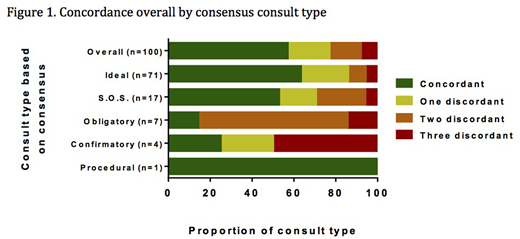Background:
Consistent classification of consult requests may lead to more productive, efficient, and collegial conversations about patient care, which can facilitate improved work satisfaction and an enhanced learning environment. We propose an organizing framework of 7 specific consultation types: ideal, obligatory, procedural, S.O.S., confirmatory, inappropriate, and curbside. We aimed to obtain validity evidence for this rubric to consistently classify consultation requests in an academic setting.
Methods:
A random sample of 100 de-identified hematology oncology consultation requests made through the online consult portal from a single academic center were selected and independently coded as 1 of the 7 consultation types by 3 hematologists and 3 hospitalists. Perfect (same consult assignment by all coders) and partial (same consult assignment by >4/6 coders) concordance was calculated. Perfect and partial (>2/3 coders) inter-rater concordance based on consult subtypes and provider specialty was also calculated. To assess if length of consult request has an impact on the classification of consult, the length of the request was compared across concordant, partially concordant, and discordant requests.
Results:
Of the 100 consults, perfect concordance was 57%, and partial concordance was 92% (Figure 1). Perfect concordance was 69% amongst hematologists and 78% amongst hospitalists. In cases without perfect concordance (n=43), hematologists agreed with each other 76% of the time, while hospitalists agreed with each other 81% of the time. Of the consults that at least 4 coders classified in the same way, hospitalists were more likely than hematologists to have perfect concordance for ideal consults (89% vs. 66%, respectively; P=0.001) but less likely to have perfect concordance for S.O.S consults (56% vs. 100%, respectively; P=0.003). Hematologists were twice more likely than hospitalists to classify a consult request as S.O.S (26.7% vs. 12.3%, P<0.001), while a greater proportion of hospitalists classified consults as ideal (74% vs. 61%, P=0.007). There was no significant difference in the word count of requests that were perfectly concordant (68+35), partially concordant (65+51), or discordant (39+22) (P=0.18).
Conclusion:
Hematology oncology consult requests can be classified into a novel rubric of 7 specific subtypes. Overall, partial concordance between primary providers and consultants was high, and perfect concordance was moderate. Hematologists were more likely to classify consult requests as S.O.S (without specific questions) than primary providers. Opportunities exist to utilize the rubric to improve communication between health care providers and to improve the medical education of trainees.
No relevant conflicts of interest to declare.
Author notes
Asterisk with author names denotes non-ASH members.


This feature is available to Subscribers Only
Sign In or Create an Account Close Modal